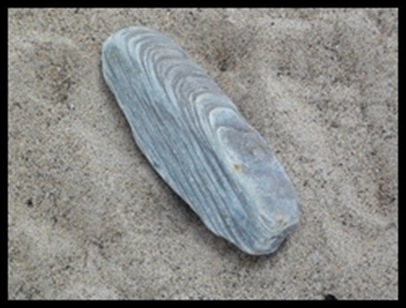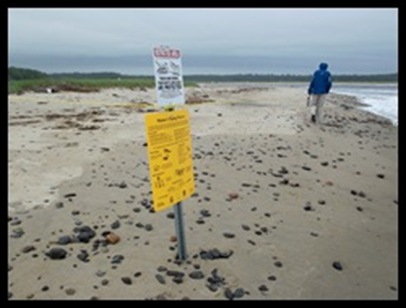Thursday June 27, 2013
site #1, Exeter Elms Campground
Exeter, New Hampshire
After visiting the wonderful Rachel Carson National Wildlife Refuge headquarters, (if you haven’t seen it, do yourself a favor and look here ), we drive next door to the Wells Reserve at Laudholm, a National Estuarine Research Reserve. There are only 28 Estuarine Reserves in the nation. If you want to see if one is near you, check this link.
I had no idea there even was a National Estuarine Research Reserve or what it was. So I need to learn. I know that Estuaries are formed where rivers meet the sea, salt water mixes with fresh water. I know they are one of the most dynamic and productive ecosystems on Earth providing essential habitat for plant and animal life, sheltering human communities from flooding, acting as buffers against coastal storms and removing pollutants from water passing from land to sea. And they charge us nothing to do all this. Pretty Amazing isn’t it?? And for years we thought they were useless and filled them to build upon.
Estuarine Research works to protect and understand these important places. They expand knowledge of coasts and estuaries, engage people in environmental learning and involve communities in conserving natural resources with the goal of protecting and restoring coastal ecosystem around the country.
The Wells Center charges a $4 admission in order to generate enough funds to qualify for matching grants from the National Oceanic and Atmospheric Administration which along with memberships and support from the Landholm Foundation account for most of the annual budget. We feel it was a small price to pay for this important work and to do the considerable upkeep on these beautiful old buildings.
The 2250 acres of lands for research include three estuaries: the Webhannet River estuary, the Little River estuary (fed by the Merriland River and Branch Brook watersheds), and the Ogunquit River estuary. The uplands include one of southern Maine's largest managed grasslands. Also on the uplands are the conserved farm buildings, which are listed on the National Register of Historic Places.
The Wells reserve manages these lands owned by its preservation partners: Maine Department of Conservation (533 acres), Rachel Carson National Wildlife Refuge (1428 acres), Town of Wells (249 acres), Wells Reserve management Authority (40 acres).
The reserve’s headquarters is here at the Laudholm Farm which is on the National Register of Historic Places. The Reserve lands are in partnership with The Rachel Carson National Wildlife Refuge.
The farm is made up of many buildings which have been restored to pristine condition. You can find a short and very interesting history of the farm from its settlement in 1643 to its current use as the Headquarters for the Reserve on their website.
There are some very interesting numbers associated with this farm.
1720 – Oldest Part of Present Day House built
500 – Pounds of wool produced in 1870
240 – years since first cultivation when George Clement Lord
purchased the farm in 1882
10 – bedrooms after 1890 renovation
4 – bathrooms after 1890 renovation
1922 – last year inhabited year round
1975 – last year used as summer residence
This is only an itsy bitsy slice of the information available in the very fine visitor’s center in the farm house. Now we are armed with information and a map and we set off to find that path to the sea.
David loves copper beach trees so he wanted his picture with this one. But he turns out to be VERY small next to this beautiful large tree.
I try to give it a hug but I’m pretty puny for the job. Look at that trunk!
There are several trails through the property. Most of them are along old farm roads.
On its way to the sea, the trail goes along side sections of the estuary of course.
And this trail ends at a boardwalk to the water. My anticipation is HIGH. My first look in a very long time at the rocky coast of Maine.
And rocky it is. No beach towels here. The rocks are literally piled up. We get pretty carried away looking at them. What an amazing variety of shapes colors, materials. We need a geologist.
We wonder what has turned this little section of the sand red.
Is it the reddish sea weed we see washed up on the shore?
Or some particular kind of rock the sand is made of?
As we walk down the coast line we see a familiar sign. These are part of many of the Gulf coast state parks in Florida indicating protected habitat for the piping plover and the least tern. We actually saw a plover here but s/he was too fast for me and my camera.
Notice David is bundled up. It is windy and drippy on the shore unlike our morning in the lovely woods at the wildlife refuge. BUT, the rain has held off for nearly 6 hours now to give a chance to make these visits. Thank you! Thank you!
If you read the post on the Rachel Carson National Wildlife Refuge, you might remember the picture of where Brook Branch and the Merriland River meet to create the Little River. Here is the mouth of the little river. We have walked down the coast to the National Wildlife Refuge Land. This morning we couldn’t get here but this afternoon we can thanks to the farm road.
But it’s too deep to walk across so it’s time to turn back.
And again we get distracted by the rocks.
What did you do today dear???
Oh I spent the a few hours enjoying the rocks.
This looks like it could be a Vermillion Cliff in the sand of the desert.
We pull ourselves away and take a circuitous combination of other paths back up to the farm. Through the estuary and then to the uplands.
Another one of those giant make your own clothing leaves. I could do a dress out of two of these I think.
What a wonderful gem the Wells Center is. So glad they are managing so many acres so well and provided me with a lovely path through the estuary to see the sea.




![RachelCarsonandWellsEstuary096_thumb[1] RachelCarsonandWellsEstuary096_thumb[1]](https://blogger.googleusercontent.com/img/b/R29vZ2xl/AVvXsEgaGkywgCoBtp3WaCIHIqZZJ-CBcHwkYbh8HbbWYVA2ppxnVxFYuSoqOrkBPVhJj9YdSFq95Ymz1-f_lrRxX_C1NS9A11T5p9KrZhsbGnmyV1KU2O1h3-2Rq4dlRh1c0J9somx9A_VQXCov/?imgmax=800)


















I could spend days looking at rocks. Sure is a variety on the beach. Glad the estuaries are being protected. They are so important to the health of our planet.
ReplyDeleteI particularly liked the rock & stroll on the beach! Must be rough footing for swimming in these waters. Not a likely venture for me.
ReplyDeleteVery cool place. I wouldn't mind a stroll on a rock strewn beach again.
ReplyDeleteNice beach, even with the rocks. You can't go wrong strolling along the ocean. A nice day, for sure! :c)
ReplyDeleteWhat a beautiful farm!! and so old....
ReplyDeleteI have never seen a copper beech tree, but recommend Maeve Binchy's "The Copper beech".
ReplyDeleteJust knew you would love it here. When we saw that beech tree, we said, "David would love this tree!!" You did a great post with lots of info! I'll have to link to your blog so I don't forget all that stuff;o))Great photo from the Gazebo!!
ReplyDeleteThanks for showing us another beautiful place to visit if we ever get to Maine. I really enjoyed your last post about Rachael Carson, too, as I didn't know there was a wildlife refuge named after her.
ReplyDeleteI've had to play a little catch up blog reading here. Great two posts! I've always been thankful that Rachel was the woman she was.
ReplyDeleteGrand Bay NWR in Mississippi is also Grand Bay NERR. It's the sister refuge of Mississippi Sandhill Crane NWR, so I've worked there. They do neat stuff.
Have I told you how much I like Maine? I like it. And for the big trunked trees just need more hugs... usually around four.
ReplyDeleteHappy Independence Day to you
I love those rocks - I think some of the ones I have in my 'collection' are from our trip to Maine. That is a big farmhouse; I like the yellow color. Jason Rylander at Defenders of Wildlife would like the Plover/Least Turn sign. He has been fighting on their behalf for years. Beautiful estuaries, beautiful sea, beautiful tree.
ReplyDeleteWhat a great tree to hug. I think you did a fine job.
ReplyDeleteI knew you'd make it to the coast of Maine!
ReplyDelete